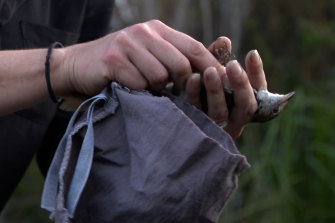
When they were released, most fluttered into the surrounding heathland, said zoologist Jordan Roberts, a natural environment project officer at Victoria’s Department of Environment, Land, Water and Planning.
“I felt ecstatic and so relieved because there were so many months of work and stress put into the planning, and making sure the birds arrived at Wilsons Prom intact.”
In NSW, there are about 1500 eastern bristlebirds but in Victoria, there is a tiny population of about 40 to 180 with low genetic diversity at Howe Flat in the Croajingolong National Park in East Gippsland.
The success of this translocation was a much-needed glimmer of positivity in a week when the five-yearly State of the Environment scorecard showed Australia suffered catastrophic losses of wildlife and habitat, and conservationists pleaded with the Albanese government to invest more to halt the escalating rate of species extinction.
Environment Minister Tanya Plibersek said the report detailed how important it was to act to protect Australia’s endangered species.
“We are working across jurisdictions with our Victorian and NSW colleagues to ensure these bristlebirds have the best possible chance to establish a new population,” Plibersek said.

A wildlife expert examines a captured eastern bristlebird.
It’s not the first time the endangered state of bristlebirds has prompted human intervention. During the Black Summer bushfires of 2019-20, bird handlers flew on a Defence Force Chinook helicopter to capture an “insurance population” of 15 eastern bristlebirds before the fires swept through Howe Flat and decimated their habitat. They were almost wiped out in Victoria.
In recent history, there have been no bristlebirds at Wilson’s Prom, but there is anecdotal evidence naturalists saw and heard them there between the late 1800s to 1970s, Roberts says. Scientists believe the birds were widespread throughout southern Victoria before British colonisation.
Wilson’s Prom is buffered by the cooling air of the Bass Strait against the worst pressures of climate change and increasing temperatures, says Dr Mark Norman, the chief conservation scientist at Parks Victoria. “It’s always 5 or 10 degrees cooler than the mainland, so it’s an ideal place,” he adds.
Loading
Roberts says the findings in the State of the Environment report this week were “the kind of thing environmentalists have been screaming for many, many years”, adding that eastern bristlebirds are the perfect example of a species that will be affected by fires because of increasing temperatures.
“Obviously, the bristlebirds coming to Wilsons Prom is a wonderful story, but unfortunately translocations like this will become so much more frequent and common,” she said.
Victorian Environment Minister Lily D’Ambrosio said the 50,000-hectare Wilsons Prom sanctuary would shield wildlife from introduced predators.
Loading
“We’re working across jurisdictions to protect our unique biodiversity and delivering record investment ... to foster our precious native plants and animals,” D’Ambrosio said.
Her NSW counterpart, James Griffin, said the partnership with Victoria meant NSW could share its expertise to save this Australian species.
The translocation was a partnership between DELWP, Parks Victoria, Parks Australia, the NSW Department of Planning and Environment, Zoos Victoria and Currumbin Wildlife Sanctuary.
Get to the heart of what’s happening with climate change and the environment. Our fortnightly Environment newsletter brings you the news, the issues and the solutions. Sign up here.









 Add Category
Add Category